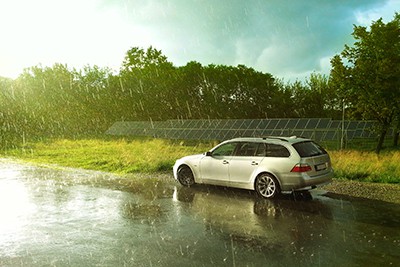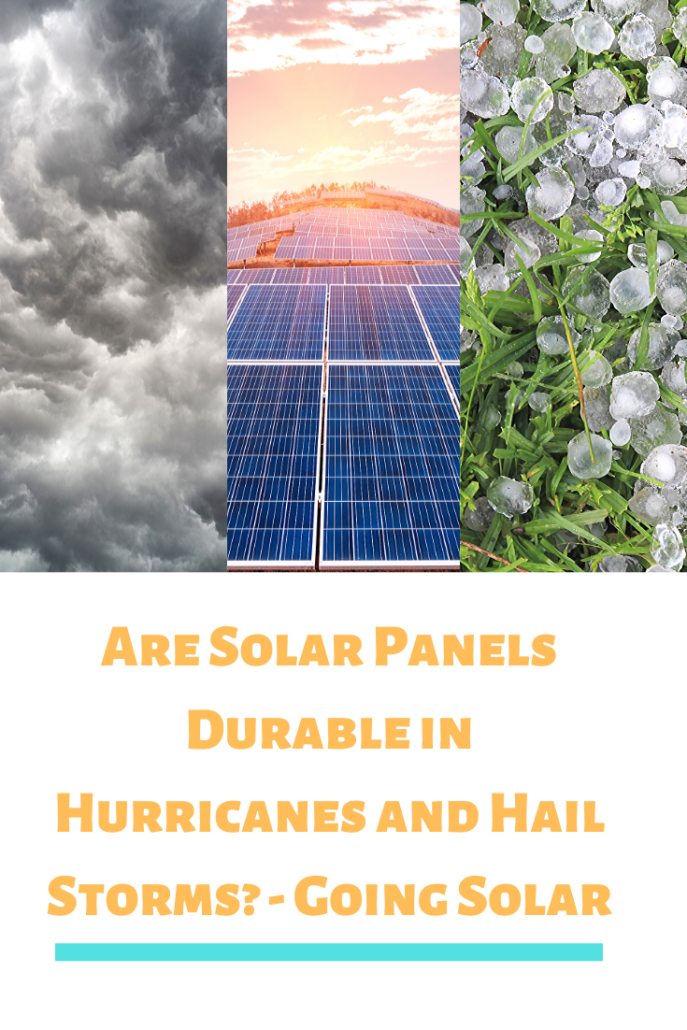
Solar panels and hail are not usually talked about in the same sentence unless its someone asking about the damage of panels.
High efficiency solar energy panels are not thought to be durable and many homeowners worry that if they were to install panels on their homes, hail or a strong hurricane could possibly damage them which would cost them thousands of dollars in repair costs.
So, what should consumers know about the most durable solar panels before making the decision to install them on their homes?
- What Are Solar Panels Made Of?
- How Do Solar Panels Withstand High Winds?
- Are Solar Panels Hail Proof And Hurricane Resistant?
- Do Warranties Cover Damage Of Solar Panels?

What Are Solar Panels Made Of?
Perhaps the reason why solar panels get the reputation for being so fragile is because of what their components are. The individual solar cells which make up a solar panel are usually made of silicon which, when standing alone, is a fairly brittle material. Additional materials included in a solar module are aluminum, some other more precious metals, and glass. While none of these materials seem to durable on their own, when they are brought together, they become an extremely durable surface. The most durable solar panels have been thoroughly tested by laboratory technicians. Solar panels are put through similar tests as a car would while going through crash testing. The engineers seek to find out just how much these modules can take before failing or breaking. Luckily, solar energy residential systems are able to use these same solar panels on their roofs as are thoroughly tested by industry professionals.

How Do Solar Panels Withstand High Winds?
One of the most common designs of a solar energy residential system is that the modules are usually mounted parallel to the roof. At times, there is little more than six inches of space between the bottom of the panel and the surface of the roof. This helps the panels on the array remain highly aerodynamic. This allows even high winds to glide over the solar panels without creating too much up force. Even if there was some up force created by the wind, there are industrial strength bolts which hold the racking unit to the roof which then firmly secures the solar modules. The combination of being designed as aerodynamic as possible and proper securing by the installer guarantees that the solar modules will remain on the roof as long as the roof remains intact through an extreme storm. When completing a home project solar energy installers should be monitored closely because you will want to be sure that this part of the process is completed correctly. The most common reason for a system not being able to withstand high winds is because of an error by the installer.

Are Solar Panels Hail Proof And Hurricane Resistant?
Hail resistant solar panels are simply solar panels meaning there is no special type that you can buy that are specifically hail resistant. Solar module engineers take special precautions to make sure that the surface layer of glass is highly resistant to being hit with a variety of objects including hail. The ability to include glass that was clear enough to allow light through while still remaining strong enough to be resistant against things like hail was one of the many solar energy breakthroughs for scientists. Another impressive solar energy statistic is that solar modules can withstand wind up to 140 miles per hour before starting to get damaged. The importance solar energy installers have in this process cannot be understated. The better your system is installed, the more wind resistant the system will be. Solar energy harnessing can occur in all types of environments, even those more prone to extreme weather events. Solar panels hail and hurricane resistance make them a great choice for consumers all over the country.

Do Warranties Cover Damage Of Solar Panels?
An extremely surprising solar energy statistic to many is that solar panels are often covered by warranties for up to 25 years. This means that if they begin to malfunction, for a variety of reasons, they will be fully replaced by the solar panel manufacturer.

Warranties for high efficiency solar energy modules cover things like heat cracking, diode failure, or individual cell failure within the whole module. Additionally, solar modules which are damaged by hail are also covered by this same warranty. This again shows how confident solar module engineering teams are that their product will hold up to even the worst weather events. It is important to review a solar panel company before agreeing to purchase their product. Because these warranties may not be used until fifteen or twenty years in the future, you have to be relatively certain that the company will be around in a few decades to process the warranty claim. If they no longer exist, there will be no one to process the claim and you are left replacing the damaged panel on your own dime. To accurately project solar energy repair costs and become more comfortable with this number, homeowners should familiarize themselves with the specific warranty policy of their solar panel provider.
Solar panels hail resistance often surprise consumers. After all, hail is known to cause millions of dollars of property damage all across the globe every year. Solar energy harnessing is about more than just having enough sunlight and designing a product that will have the highest possible efficiency. It is also about designing a solar panel that will hold up in even the worst hail storms and hurricanes. The importance solar energy will play in the future of our country is unmistakable, luckily, they have been designed in a way that will make them last for decades to come even when going through some of the most extreme weather events. With the ever improving technology, there may even be solar energy breakthroughs on the horizon which will make them even more resistant. Homeowners should never be afraid of the combination of solar panels and hail. Hail resistant solar panels are sure to keep your system running for decades to come.
